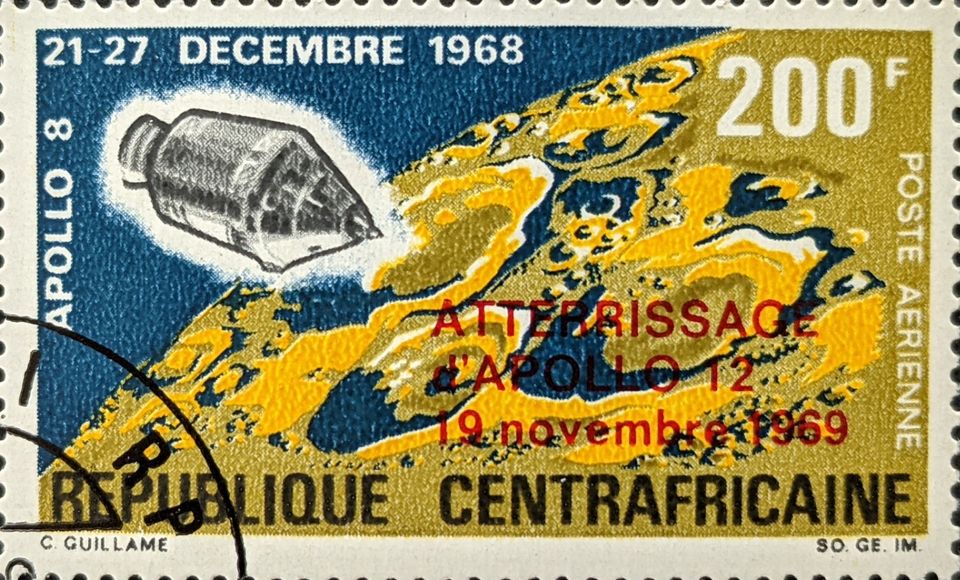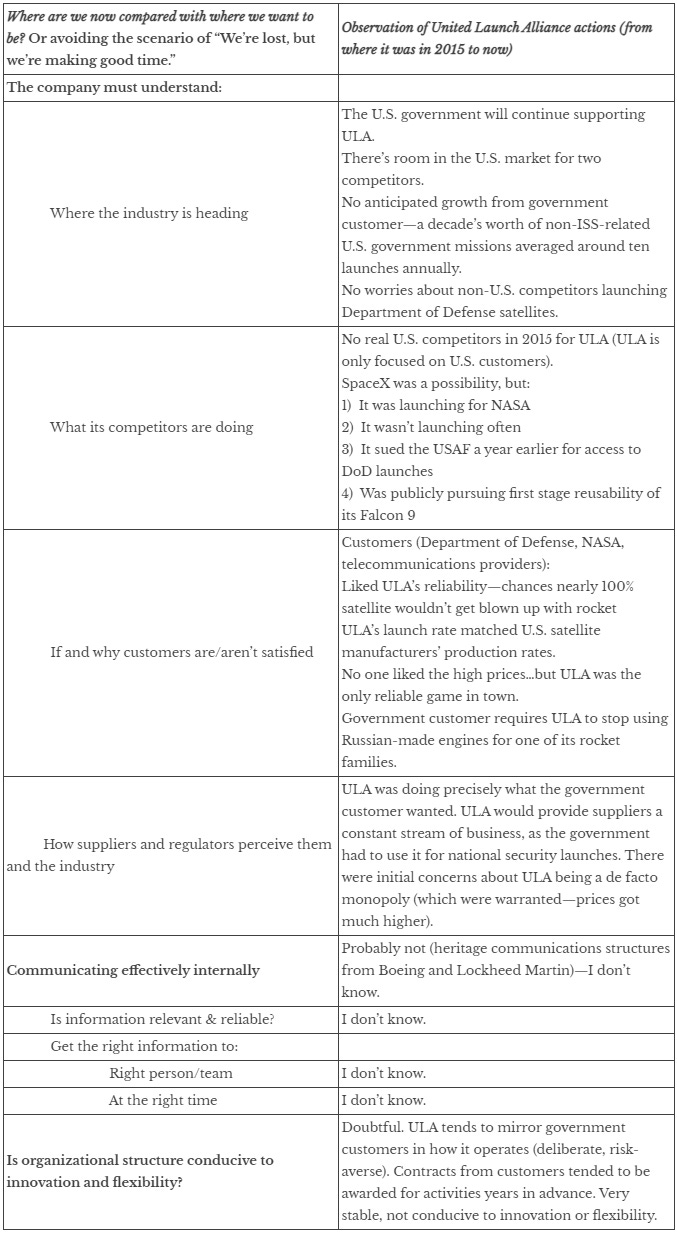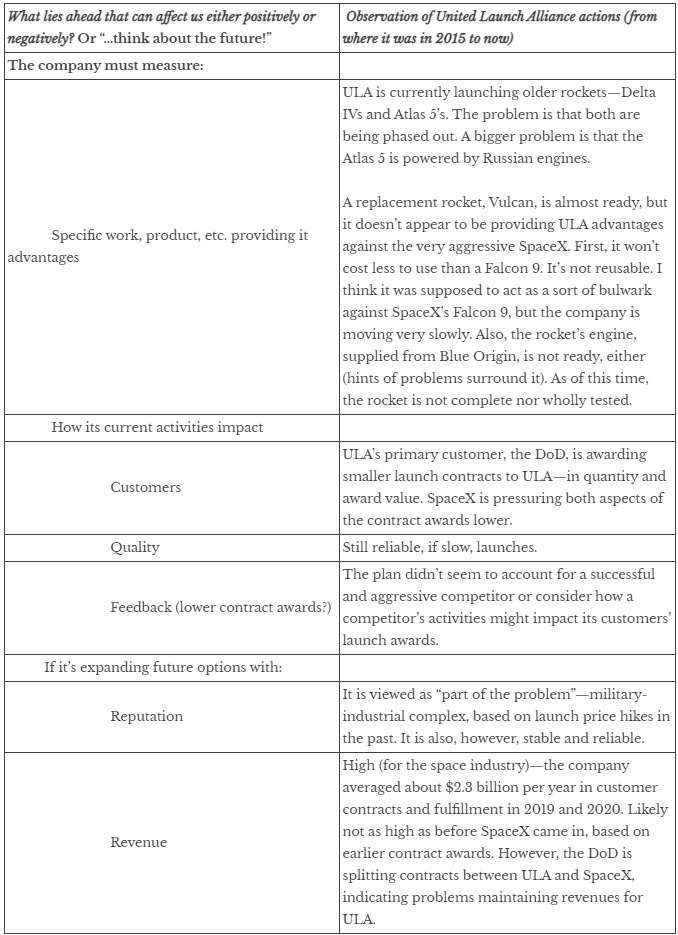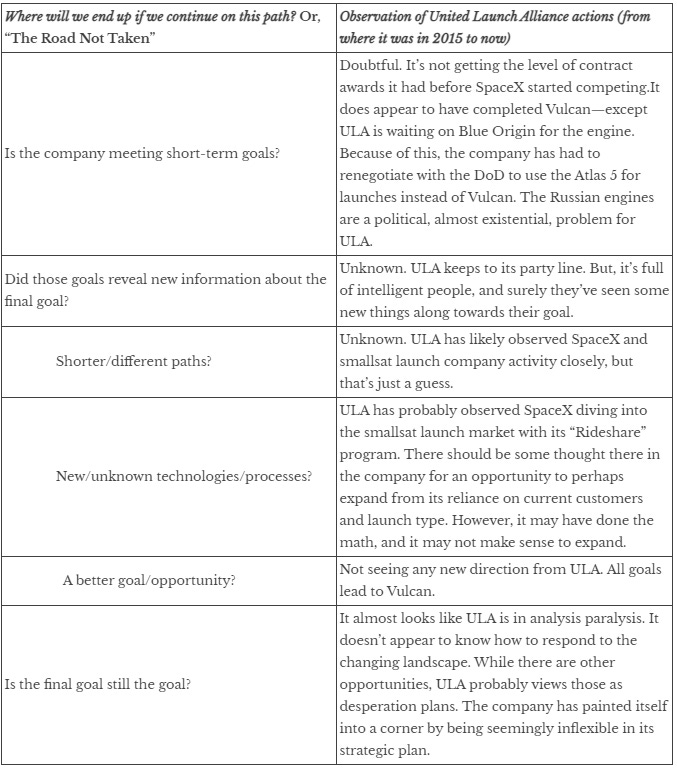Into the Gap Analysis (of a space company)

The following came from a discussion answer I provided for one of my classes. It asked for the characteristics an organization’s plan should possess once it had outlined a plan based on a gap analysis. And for those who aren’t sure what a gap analysis is, it’s essentially the process of figuring out where the organization is and where it wants to be while embracing innovative concepts and processes. The following three questions sum up what needs to happen during a gap analysis:
- Where are we now compared with where we want to be?
- What lies ahead that can affect us either positively or negatively?
- Where will we end up if we continue on this path?
These questions come from Bruton & White’s “The Management of Technology and Innovation.” I won’t regurgitate the characteristics, but I did interpret the necessary evaluations the book’s authors listed that support answering those three questions, as follows:
Where are we now compared with where we want to be? Or avoiding the scenario of “We’re lost, but we’re making good time.”
The company must understand:
Where the industry is heading
What its competitors are doing
If and why customers are/aren’t satisfied
How suppliers and regulators perceive them and the industry
Communicating effectively internally
Is information relevant & reliable?
Get the right information to:
The right person
At the right time
Is its organizational structure conducive to innovation and flexibility?
What lies ahead that can affect us either positively or negatively? Or “…think about the future!”
The company must measure:
Specific work, product, etc. providing it advantages
How its current activities impact
Customers
Quality
Feedback (returns)
If it’s expanding future options with
Reputation
Revenue
Where will we end up if we continue on this path? Or, “The Road Not Taken”
Is the company meeting short-term goals?
Did those goals reveal new information about the final goal?
Shorter/different paths?
New/unknown technologies/processes?
A better goal/opportunity
Is the final goal still the goal?
Depressing Realizations
First, for those of you who look at these and think these are fundamental foundational actions--congratulations! You are a minority (and probably not in a leadership position).
While I was interpreting the necessary steps, I realized a few things. 1) I’ve never worked in an organization that does any of these things (sadly). That fact means that: 2) they didn’t have a clue what they were doing. And this includes a slew of managers who purported to be entrepreneurs, if not in fact, then in spirit. Their actions over the years indicate otherwise.
It also made me ponder that 3) there were startups and other companies (emerging/existing) in the space industry who have no idea what their final goal is. Some have no idea what the lay of the current industry is, basing their reality (and their futures) on fictionally favorable auguries from supposedly responsible consulting/banking groups.
Whether this is because of a lack of objectivity/honesty in the changing landscapes (technology, business, competitors), personality/politically-driven agendas, or an attempt to reach goals the business has no expertise, technology, and/or business in, the result will be the same: a failure.
All of the above, including my anecdotal experiences, leads me to believe that 4) this gap analysis might be a helpful tool to compare a company’s actions in an industry that is changing: the space industry. Therefore, I decided to play around with this format and information, using United Launch Alliance as an example of where it might have looked as it (hopefully) conducted a gap analysis because of the changing launch landscape in the U.S.
I already completed much of the analysis work about ULA’s challenges in three parts (Part 3 ties it up here (Links to an external site.)). I wondered if framing it this way would have been more useful. Note that the column on the right is about ULA’s activities, public statements, etc.
Let’s start with where ULA has publicly said it wants to be--its mission statement. ULA’s mission is: SAVE LIVES, EXPLORE THE UNIVERSE, CONNECT THE WORLD
It sounds grand, but in plain speak, it refers to conducting military missions (saving lives of troops/protecting country), conducting NASA missions (sending expensive satellites out from Earth), and telecommunications (communications satellites, which ULA occasionally launches). So the mission statement just affirms ULA will do what ULA’s always done: launch government satellites, and sometimes, commercial communications satellites--expensively when possible.
ULA is looking at where it is and has decided that that’s where it would still like to be—at least based on its mission statement. Going down the list, then.
The Analysis



To be clear, there are many guesses in there (especially in the “new information” section). I have no “in” with anyone working for the company. I’m writing those guesses based on observations, statements, and activities of ULA.
The gap analysis is a tool, one that helps an organization evaluate the truth of things--if the company is willing to accept the truth. It’s not a tool that fits everywhere, but it can be useful for most companies--especially those purporting to be innovative and “new.” It also can be useful for those of us trying to figure out externally how a company may be faring, aside from the simplistic use of revenues (which also may not be available).
While ULA isn’t an innovative company, it could act innovatively if it chose. I believe ULA is absorbing new space industry knowledge thanks to SpaceX’s and others’ activities. But it believes its explicit focus—government launch—is supposed to keep it solvent while implementing a stopgap solution, Vulcan. While this short-term goal is close to completion, it isn’t complete, forcing ULA to use its older, more politically distasteful rocket for military launch.
Again, it’s long, but maybe this shows one way to use Bruton and White’s information in the context of the real world? Of course, any comments/criticisms are always welcome.




Comments ()